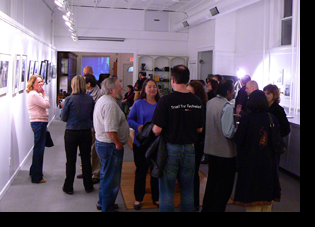
Best of 2010 at the Photo Center of Troy, Review
By Briavel Schultz, Assistant Editor of The Free George
 The cold winter months are particularly unpleasant, unless you’re an avid skier. For the rest of us, icy windshields, extortionist heating bills, and skies as gray as pavement can really be a downer. It’s important to remind ourselves how much in this world is vibrant and lovely. An intriguing mental vacation is currently on exhibit at the Photo Center of Troy in their Best of 2010 Photo Exhibit.
The cold winter months are particularly unpleasant, unless you’re an avid skier. For the rest of us, icy windshields, extortionist heating bills, and skies as gray as pavement can really be a downer. It’s important to remind ourselves how much in this world is vibrant and lovely. An intriguing mental vacation is currently on exhibit at the Photo Center of Troy in their Best of 2010 Photo Exhibit.
Represented are a huge range of photography styles and production methods, mostly all from local artists. The exhibit was juried by 2010 photo regional winner, Jennifer Lynn Morse. You can explore the exhibit, which fills the entire downstairs of the Photo Center, and then vote on which you think deserves the People’s Choice Award.
I certainly don’t mean to influence your personal vote, but I would like to fill you in on my personal favorites to give you a taste of what’s there. Shamelessly, all of my choices have something to do with warm weather.
Traditionally in art, fruit gets stuck in the classic/stuffy category or the pop-culture / kitschy category, but my favorite photograph was actually of a piece of fruit, called Lime by Jeffrey Altman (ID #59). Poised and invigorating at the same time, the simplicity of the photo, and the quality of light and color make it somewhat irresistible to the viewer. A circular slice of lime fills the photograph, like a green, juicy sunburst; within it, a light source emanates from within the lime, illuminating every fleshy bit of pulp membrane in detail. The aqueous green of the fruit is contrasted against a gray background that serves as a dark halo. The fact that it looked totally delicious and I prefer limeade to lemonade is neither here nor there.
Another photo that struck me was Cape Cod by Gary Tobler. A giclée photograph that claims to be of Cape Cod, but resembles heaven. The image is so soft, it’s as if the picture is only a cloud resting on the paper. Depicting a beach fence, with a sand hill on one side and footprints headed towards the ocean on the other. Tobler’s use of color is particularly intriguing—the fence is a soft brown, the beach is peach, the sky is gray and light pink is powdered throughout.
John Peterson has an entry called Tulum Mexico (#16) that looks like an impressionistic painting but is really an archival print photograph. It could just be a collection of hazy stripes — a dark tan stripe for sand, a brilliant bright blue stripe for ocean, and dark blue for the sky. Yet the subtle fadings and movements of color unmistakably depict a burning hot beach paradise.
Though the photographs filled the whole spectrum of subject matter, Morse did create two groups for similar works. The first is called American Surfaces, which Morse explains: “Among the color, beauty, and chaos there are quiet spaces that are a part of us and this land.”
Two photos standout in the American Surfaces collection, Akemi Hiatt’s Eat Beef and Jeff Lansing’s Summer Ice Cream. Eat Beef shows a scene of an empty highway cutting through a pristine prairie with miles and miles of blue sky and fluffy white clouds above. The punchline of the picture is a giant, lone billboard that reads “Eat Beef.”
Lansing’s Summer Ice Cream is a scene of teen girls enjoying ice cream on a boardwalk overlooking the ocean — a perfectly ordinary picture except for its overwhelming power to make you ache for summer. Summer Ice Cream captures that easy, carefree feeling of being warm, enjoying the salty breeze, and tasting creamy cold vanilla on your tongue. Take me there now, please.
The more mystical collection is called Stranger than Fiction, which Morse explains with, “Even though time tells us that every photograph we encounter is in fact a past happening, these images, because of their ambiguous settings, also foreshadow the future.”
Along these lines, Berry Junjulas’s Untitled is one of the most romantic photos in the exhibit, capturing a nighttime garden or patio through an old fashioned hanging street lamp, red potted flowers, and three statues watching from the shadows. The shadows seem inviting, the light from the lamp looks real. Everyone will have their own take on this photo, but for me it can only be showing the patio at the Capulet’s party right before Romeo meets Juliet.
Back to Top